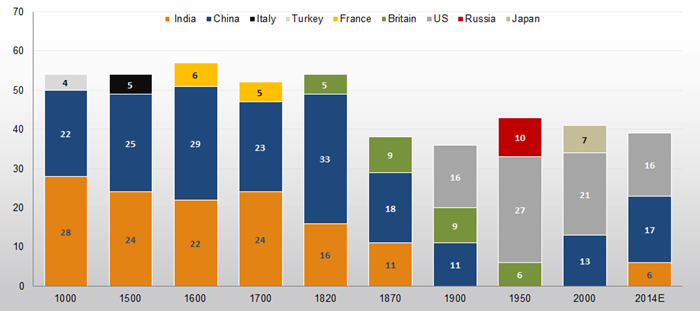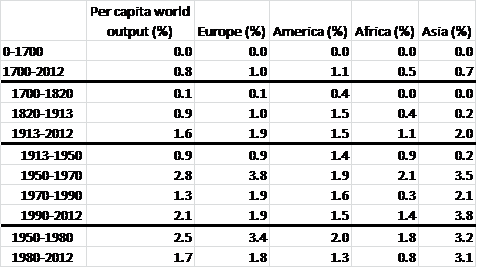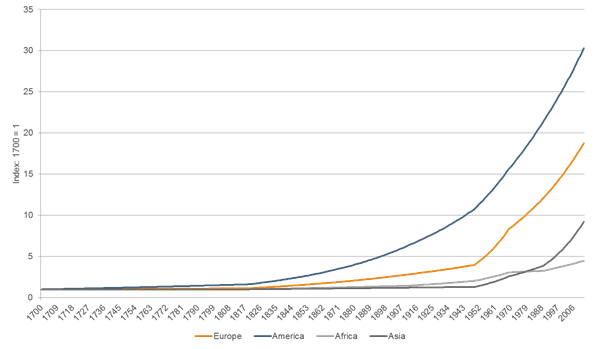The dominance of the West over the last couple of centuries makes the rise of China and India in the last couple of decades feel somewhat unnatural. However, if one casts one’s eyes further back in time, it should perhaps be no surprise that for much of recorded history the largest populations on Earth made the largest contribution to economic activity.
It should perhaps be no surprise that for much of recorded history the largest populations on Earth made the largest contribution to economic activity.
This has been the case for most of the last 1,000 years, as shown in a chart originally produced by quantitative economic historian Angus Maddison[1], which we saw in The Economist.
World’s biggest three economies’ GDP at PPP* as % of world total (historical output within the boundaries of modern countries)
 Source: Angus Maddison; IMF; The Economist, accessed 28 May 2015.
Source: Angus Maddison; IMF; The Economist, accessed 28 May 2015.
* Purchasing power parity
Clearly, the summation of 1,000 years of economic history in one chart is fraught with difficulty – we cannot speak to the veracity of the data nor the integrity of the methodology underlying these numbers. However, we find it an interesting thought experiment to consider what transpired over the last 1,000 years to cause the world’s largest population centres to be relegated to minor players economically, which we think is broadly true.
The Dark Ages were not dark everywhere
Were a Martian to have visited our lovely blue planet in the year 1000CE (Common Era), it is unlikely she would have picked Europe as the region which would revolutionise economics, technology and human potential[2]. The glories of classical civilisation had well and truly faded. For instance Rome had slumped to the status of a minor town, with a population of perhaps 5,000[3]. 1,000 years ago, the Dark Ages were dark indeed in Europe, but elsewhere this was not the case.By 1000CE the Abbasid Caliphate, centred in Al Mansur’s beautiful and cosmopolitan city of Baghdad, had overseen an enormous translation effort of the great works of Greek and Roman scholarship. The Muslim world led humanity in mathematics, medicine and the sciences. From this period we derive the word “algebra” from the title of a work “Hidab al-jabr wal-muqubala”, written by Mohammed ibn-Musa al-Khowarizmi (from whose name we derive the word “algorithm”)[4].
As early as 700CE the Chinese city of Chang'an (now Xi'an) was probably the world's largest and richest city. Merchants and visitors from West, South, Southeast, and East Asia arrived frequently, and Tang China functioned as the epicenter of an international culture reflected in the visual arts of Korea and Japan. By the 9th Century "exchange notes," negotiable certificates dubbed "flying money," were in circulation. They were the precursors of banknotes, widespread in China by the early eleventh century. The Chinese invented printing in the 9th Century, in the form of woodblock prints. Later innovations in China in the 11th and 12th centuries under the Sung Dynasty included gunpowder and the compass[5].
China was centuries ahead of the rest of the world in areas as diverse as steelmaking, armaments, transportation networks and finance. The results included significant exports of manufactures thanks to the Sung Dynasty’s expanded merchant marine and a prosperous consumer society. This in turn benefited India[6].
Around 1000CE the area of modern day India was a land of diverse empires and religions, from the Sunni Ghaznavid Dynasty in the north to the Hindu Chola Empire in the South[7]. The Chola in particular prospered by exporting products including manufactured textiles, spices, drugs, rhinoceros horn, amber, coral, aromatics and perfumes to China[8].
Europe, by contrast, was an almost entirely rural, unsophisticated backwater in the early medieval period. There were only a few towns across the entire continent of greater than 10,000 people, versus Sung China’s largest city Hangzhou, whose inhabitants numbered approximately 1,000,000. Life was much less sophisticated in the West than in the East, in areas such as finance, literacy, diet, culture, art, commercial endeavour, trade and industrial specialisation[9].
But something changed.
The explosion of modernity
It seems that economic output per head of population changed very little, if at all, for much of human history[10]. However, from some point in approximately the 18th century, the world changed quite dramatically. For perhaps the first time in human history, significant growth in per capita economic activity was achieved. And it appears that this per capita revolution occurred in Europe and its offshoot America well before it took hold in either Africa or Asia (see table from Piketty below).
The result is that you, your parents and your grandparents all grew up in a period in which one part of the world – Europe and America taken as a whole – had been growing much faster on a per capita basis than the rest of the world for perhaps two centuries.
Per capita output growth since the industrial revolution (average annual growth rate)

Source: “Capital in the Twenty-First Century”, Thomas Picketty, Editions du Seuil, 2013, p94.
Note: Angus Maddison puts total per capita economic growth over the period 1000CE to 1820CE at 50% total, while Noell, Smith and Webb put it at 0.05% per annum for the same period – these are mathematically almost identical (see footnote 9 for references).
It is very difficult to get a sense of the power of compounding small numbers. To aid in conceptualising the importance of these different growth rates we have included a chart depicting an index, with all regions starting at 1 and compounding at the growth rates estimated by Piketty.
Index, applying per capita output growth since the industrial revolution according to Piketty

Note: This is indicative only and is designed merely to show the significant impact of small differences in growth rates over long periods of time.
Why did Europe lead the explosion?
This is a big question[11].
A partial answer may lie in culture: Western culture is both the product of and the producer of highly sophisticated and rigid cultural institutions which may have been crucial in allowing for the kind of self-controlled, repetitive and long-term goal oriented behaviour necessary for endeavours such as formal education or scientific research[12]. Further, Western acculturation gave rise to changes in individual behaviour and changes in social power appropriate for the centralisation of state power and the power of capital[13].
Europe has an alphabetical form of writing, plus a cultural separation of Church and state, both of which may have helped the explosion of printing from 1500CE or so[14]. There was a strong tradition in Christianity of the subjugation of nature to man – very different to the animistic beliefs of some Asian religions[15]. For some the seeds of modernity are to be found in Christianity's emphasis on reason and free will[16] (at least relative to other religions).
Magna Carta’s signing in 1215 established limited protections for a group of nobles versus the sovereign (or at least it attempted to – the parties fell to fighting shortly after its signing and ceased only upon King John’s death in 1216). This was an early step along the path to the formation of the rule of law and respect for property rights[17]. This institutional curtailment of absolute power and respect for individual rights and property appear crucial, allowing for disruption to be tolerated (to a degree) and innovation to be rewarded (much of the time). This seems very different from China for example, which invented the blast furnace but killed off the private iron production in the 11th century as it was seen as a threat to Sung power[18].
Some see the increase in per capita economic activity late last millennium not as a social or economic phenomenon, but as a thermodynamic one. Humanity, with the discovery of technologies to exploit fossil fuels, hit upon the means of physical liberation, by employing forms of energy with hitherto unimaginable energy return on investment[19].
Some lessons from history
The causes of the explosion in per capita productive capacity were in part institutional, in part technological and clearly complex and multivariate.
One must not assume, however, that any of the causes of the per capita explosion are inherent, immutable or non-replicable. After centuries of lagging behind, Asia has grown faster than any other region since at least 1970 (again, see Piketty’s table above) and this continues to this day[20]. It appears that at least some of the lessons of history have been learnt.
Examination of why Europe led the world into the per capita explosion reminds us somewhat of an attempt to explain the exquisite set of variables required for life to exist in our universe. Everything seems so perfectly designed for life to exist, precisely because we exist in the universe in which life exists[21]! By extension, consider if you will that in 1000CE one may have been pondering exactly why Islam had swept all before it across much of the known world and within three centuries established a colossal empire and was extending the frontiers of human thought.
Over long periods of history, centres of economic and political power shift dramatically. Recall our little green visitor in 1000CE. Such a visitor might be astounded upon returning to find that the agrarian, uneducated, backward region to the west of Asia had settled new continents, transformed science, driven technological innovation and created wealth unimaginable forty generations ago[22].
In viewing Asia’s rapid growth, but unfamiliar social and political institutions, we believe many in the West feel not merely scepticism, which is appropriate, but outright disdain, which is ill-considered. Such disdain breeds neglect of investment opportunities on the part of global investors, a neglect we hope to exploit.
DISCLAIMER: The above information is commentary only (i.e. our general thoughts). It is not intended to be, nor should it be construed as, investment advice. To the extent permitted by law, no liability is accepted for any loss or damage as a result of any reliance on this information. Before making any investment decision you need to consider (with your financial adviser) your particular investment needs, objectives and circumstances. The above material may not be reproduced, in whole or in part, without the prior written consent of Platinum Investment Management Limited.



